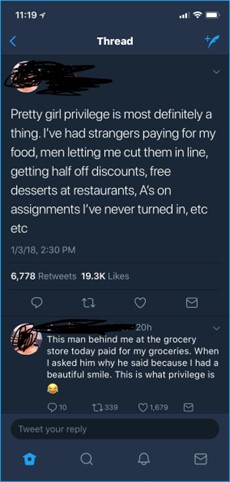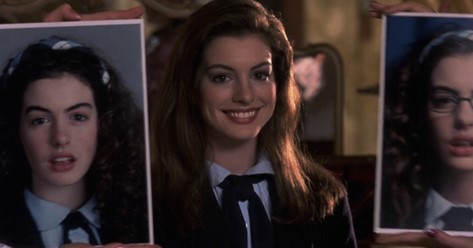Webb, Constance

Perhaps one of the most unnoticed social injustices has been staring us straight in the face: ‘pretty privilege’…So, what is it?
The buzz-phrase describes benefits associated with conforming to societies beauty ideals, which, despite being culturally and temporally variable (Hakim, 2010), are usually ethnocentric, thin, cis-gendered, young, and non-disabled bodies. Those deemed beautiful get preferential treatment, based on the associations between beauty and talent, intelligence, social success, and health (Feingold, 1992): this phenomenon has also been acknowledged as a possession of ‘erotic capital’ (Hakin, 2010).
Some theories of where this priority for prettiness comes from have acknowledged the role of beauty in fundamental biology (Muñoz-Reyes et al, 2015). Attractiveness plays an important role in our ability to meet potential mates. But if attractiveness is a sign of genetic fitness, why does it cause disparity between individuals who are not being considered as potential partners, for example in the workplace (Mobius and Rosenblat, 2006) or education (Mehic, 2022)?
Another theory is that it stems from confidence instilled in individuals at an early age. Research in labour economics indicates that physical attractiveness can be a self-fulfilling prophecy for success; teachers expect better looking children to outperform their peers, so devote more attention to those predicted to have greater potential. This preferential treatment builds confidence and social and communication skills (Mobius and Rosenblat, 2006). This reinforcement of confidence in looks and capability encourages success as confidence, a non-cognitive skill, increases lifetime earnings (Mobius and Rosenblat, 2006).
Mehic (2022) conducted a study which demonstrated beauty can be a productivity-enhancing product; his data showed that greater facial attractiveness impacted the outcome of in-person learning. There was a ‘beauty premium’ for attractive students, for females this no longer applied with online teaching, but for male students this premium continued.
‘Beauty premium’ also continues at work. Attractive people are more likely to be employed and employers are inclined to increase salaries by up to 10.5% above their ‘unattractive’ counterparts (Mobius and Rosenblat, 2006). Physical characteristics such as beauty, hair colour, obesity and height have all been linked to labour market outcomes (Granleese, 2016). Attractive people are (wrongly) assumed to be better at their jobs (Mobius and Rosenblat, 2006).
We see examples of pretty privilege all the time. In films and television, we see the pretty girl getting the guy or the dream job, queue Anne Hathaway getting a transformative makeover in ‘The Princess Diaries’, winning her the dreamy boy, or Jennifer Garner in ‘13 Going On 30’ when her glow up lands her a dream job and the popularity she dreamed of in school.

In real terms we see where pretty privilege benefits the beautiful around us. It might be a free drink, skipping the queue for a club entry, or just someone holding the door open, but for those who don’t fit societies ideal beauty standards these seemingly unnoticeable deeds create an obvious discrepancy.
So, what is the ugly truth behind it all?
Using the concept of ‘erotic capital’ demonstrates the power created by pretty privilege. Using ‘erotic capital’ – assets and resources gained through being stereotypically attractive – provides advantages in “social and economic processes, social interaction, and social mobility” (Hakim, 2010, p. 499), creating a personal asset, for mating and marriage markets, but also in “labour markets, the media, politics, advertising, sports, the arts, and in everyday social interaction” (Hakim, 2010, p. 499). While it is multifaceted, beauty is a central element to ‘erotic capital’, for men and women, but is more frequently deployed by women (Hakim, 2010, p. 499). Even though we can see many examples, especially in popular culture, it has been overlooked in academic studies. This can be seen as patriarchal bias; men refuse to acknowledge women using erotic capital to hold power over them, they deny its existence so women cannot “legitimately exploit their relative advantage” (Hakim, 2010, p. 499).
Lack of attention to what keeps people sitting pretty supports ‘hegemonic masculinity’. Not acknowledging it as a form of capital, a form predominantly used by women in the social world, we ignore the power it has over men, and further subordinate women. Hegemonic masculinity is normative and embodied behaviour which allows the dominance of women by men to continue; it is understood as the most honoured way of being a man, and achieved through culture, institutions, and persuasion (Connell, 2005). Through ignoring the power of pretty privilege deployed by women, domination over them is left unchallenged and hegemony is further maintained.
We can combat the use of pretty privilege and simultaneously challenge hegemonic masculinity by untraining the beauty bias through counter-stereotype training. Researchers found that counter-stereotype training significantly reduced implicit bias and once participants had been demonstrated their own bias, they became self-regulating (Burns, Monteith and Parker, 2017). Calling out pretty privilege as a powerful tool might be a step in the right direction.
Bibliography
Burns, M.D., Monteith, M.J. and Parker, L.R., (2017). Training away bias: The differential effects of counterstereotype training and self-regulation on stereotype activation and application. Journal of Experimental Social Psychology, 73, pp.97-110.
Connell, R.W. and Messerschmidt, J.W., (2005). ‘Hegemonic masculinity: Rethinking the concept’. Gender & society, 19(6), pp.829-859.
Bustle (2016) ‘The Princess Diaries’ Got Sort Of Wild. [image] Available at: 24 Crazy Things In ‘The Princess Diaries’ That You Never Thought About Before (bustle.com) Accessed: 21/03/2023
Feingold, A., (1992). ‘Good-looking people are not what we think’ in Psychological bulletin, 111(2), p.304.
Granleese, J., (2016). Lookism. The Wiley Blackwell Encyclopedia of Gender and Sexuality Studies, pp.1-3.
Hakim, C., (2010). ‘Erotic capital’. European sociological review, 26(5), pp.499-518.
Mehic, A., (2022). Student beauty and grades under in-person and remote teaching. Economics Letters, 219, p.110782.
Mobius, M.M. and Rosenblat, T.S., (2006). Why beauty matters. American Economic Review, 96(1), pp.222-235.
Muñoz-Reyes, J.A., Iglesias-Julios, M., Pita, M. and Turiegano, E., (2015). Facial features: what women perceive as attractive and what men consider attractive. PLoS One, 10(7), p.e0132979.
U/okbunno (2018) Pretty girl privilege must be stopped! [image]. Available at: https://www.reddit.com/r/humblebrag/comments/7o5bxi/pretty_girl_privilege_must_be_stopped/ Accessed: 20/03/2023
